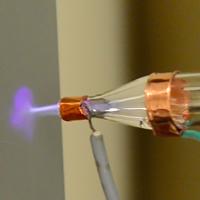How Plasma Can Print Nanomaterials on Flexible Surfaces
March 24, 2016
A new way to print nanomaterials onto 3-D objects and flexible textile materials could have an array of applications, including biosensors, batteries, and integrated circuitry.
Kristopher Sturgis
 "Printing nanomaterials, especially sensors and electronic materials on 3-D objects can be a game changer in additive manufacturing,"declares Ram Prasad Gandhiraman, a research scientist at Nasa Ames Research Center (Mountain View, CA).
"Printing nanomaterials, especially sensors and electronic materials on 3-D objects can be a game changer in additive manufacturing,"declares Ram Prasad Gandhiraman, a research scientist at Nasa Ames Research Center (Mountain View, CA).
The technique could ultimately make it simpler and cheaper to produce devices made from nanomaterials like wearable biosensors, batteries, integrated circuitry, and other biosensing devices
"This technology could be used in combination with additive manufacturing to embed sensors and electronic circuitry as an in-line manufacturing process," Gandhiraman says. "The most interesting aspect is that the electric field and plasma create highly directional printing, and it is not dependent on gravity -- meaning the print head can be oriented in any direction, not necessarily facing the ground. In essence, this technology could be used to embed sensors or electronic circuitry on any complex shaped objects as they are manufactured."
In the past, nanomaterials have been printed using aerosol printing techniques, but the materials have been difficult to produce given that they needed to be heated to several hundred degrees in temperature so that they could be consolidated into a thin film for use. These extreme temperatures made it impossible for researchers to print them on materials like cloth or paper as they would simply burn through.
"The inkjet printers simply spray the nanomaterials in a highly controlled fashion, so that the ink in the cartridge is placed drop by drop onto the substrate,"Gandhiraman explains. "In order to increase the adhesion and to achieve the required material properties, post thermal processing is required. This limits the nature and type of materials that can be processed, so printing on 3-D objects with complex patterns is not possible with inkjet printers."
This new plasma method circumvents the issue, however, as it can be used at temperatures no warmer than 40°C, enabling them to be deposited on a variety of materials like plastic, paper, cotton, and most any other kind of textile.
Gandhiraman and his group were able to demonstrate the new method when they were able to print a layer of carbon nanotubes on paper. The group then mixed the nanotubes into a plasma of helium ions before dispensing them through a nozzle onto paper. Once on a sheet of paper, the plasma enables the nanoparticles to form a consolidated layer on the paper without any need for external heat to solidify them.
The group also found that the presence of certain molecules can alter the electrical resistance of the carbon nanotubes -- meaning that the change could be measured and used to determine the concentration of certain molecules. This discovery enabled them to print a chemical sensor that could detect ammonia gas and a biological sensor that can detect dopamine, an organic molecule that is often linked with central nervous systems disorders like Parkinson's disease and epilepsy.
"The impact of this technology could change the way biosensors are fabricated,"Gandhiraman says. "The plasma jet printing could be used for fabricating biosensors and chemical sensors. Functionalization of biosensor surfaces and surface engineering of microfluidic devices can be carried out in a fraction of seconds compared to the routine wet chemical methods that take hours. The plasma printer can also print signal transduction elements, signal amplification nanomaterials, and signal bioactive and passive coatings on biosensors and microfluidic devices in rapid fashion. The printing can also be performed on a specific location on the diagnostic device which eliminates the need for masking."
When it comes to printing, there's no question the technology has taken great leaps recently. From the enhancements in 3-D printing, to the development of bioprinting as a tool for regenerative medicine, the effects of advanced printing methods continue to shape the future of medtech. Gandhiraman says this new printing method can further push the envelope, accomplishing tasks that inkjet printing simply cannot do.
The group says the new technique is ready for commercialization and expects it to be as cost-effective as it is simple to use.
"It won't be long before you see the plasma jet printer in the manufacturing line," Gandhiraman says. "Our objective is to develop the core technology and demonstrate its applicability in a wide range of fields, including sensors and printable electronics. We hope that the full potential of the plasma printer will be realized sooner or later."
Learn more about cutting-edge medical devices at BIOMEDevice Boston, April 13-14, 2016. |
Like what you're reading? Subscribe to our daily e-newsletter.
About the Author(s)
You May Also Like


